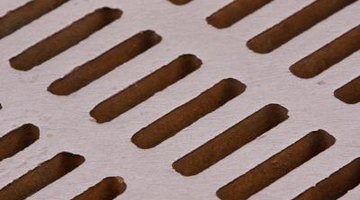How to Calculate the Interception Capacity of a Trench Drain
A trench drain, also known as a grate inlet or slotted drain, is an orifice used to manage the flow of water on paved surfaces. The interception capacity of a drain is a numerical representation of the opening's draining efficiency. There are two equations for interception capacity that apply to trench drains. The depth of the water flow at the drain determines which equation should be used to calculate interception capacity.

Step 1
Measure the dimensions of the drain with a ruler or tape measure. Two variables, perimeter "P" and effective area "A" of the drain, are required to complete interception capacity equations.
Calculate the perimeter by adding the length of each of the drain's sides, excluding the bars of the grate and any side of the drain that borders a curb.
Multiply the length of the drain by its height, then subtract the surface area of the grate or bars to determine the effective area. Record all measurements in feet. Convert inches to feet, if necessary, by dividing measurements in inches by 12.
Step 2
Measure the depth "D" of the water at the curb near the drain with a ruler or rod. Record this measurement in feet. If the water depth is less than 5 inches, the drain is treated as a weir, or enclosure, for the purpose of calculating interception capacity. In deeper water, the drain is treated as an orifice instead of a weir, so a different equation is required to determine its interception capacity.
Step 3
Multiply the perimeter of the drain by the water depth for depths less than 5 inches. Multiply this number by 3. The 3 is the weir coefficient and it is a constant, which means it does not change depending on the variables.
Take the final product of these three numbers to the power of 1.5. The resulting number is the interception capacity of the drain in cubic feet per second.
Step 4
Multiply the depth of the water by 2 for depths greater than 5 inches. Multiply this number by 32.2 feet per second. Take the product of the three numbers to the power of 0.5.
Multiply the resulting number by the effective area of the drain. Multiply the product by 0.67, which is the constant orifice coefficient. The result of these calculations is the interception capacity of the drain in cubic feet per second.
References
Tips
- Turn all measurements into feet before entering the variables into the equations.
Warnings
- Be careful while measuring the water depth and drain dimensions. The area around the drain is often slippery and may contain hazardous debris.
Writer Bio
Quentin Coleman has written for various publications, including All Pet News and Safe to Work Australia. He spent more tan 10 years nursing kittens, treating sick animals and domesticating semi-feral cats for a local animal shelter. He graduated from the University of Delaware with a bachelor's degree in journalism.
Photo Credits
- Hemera Technologies/AbleStock.com/Getty Images
More Articles



